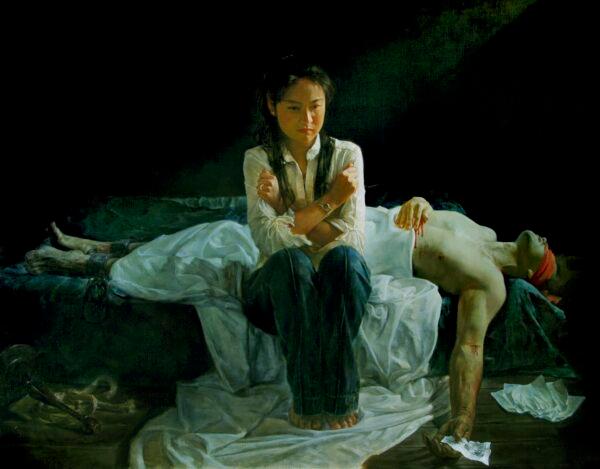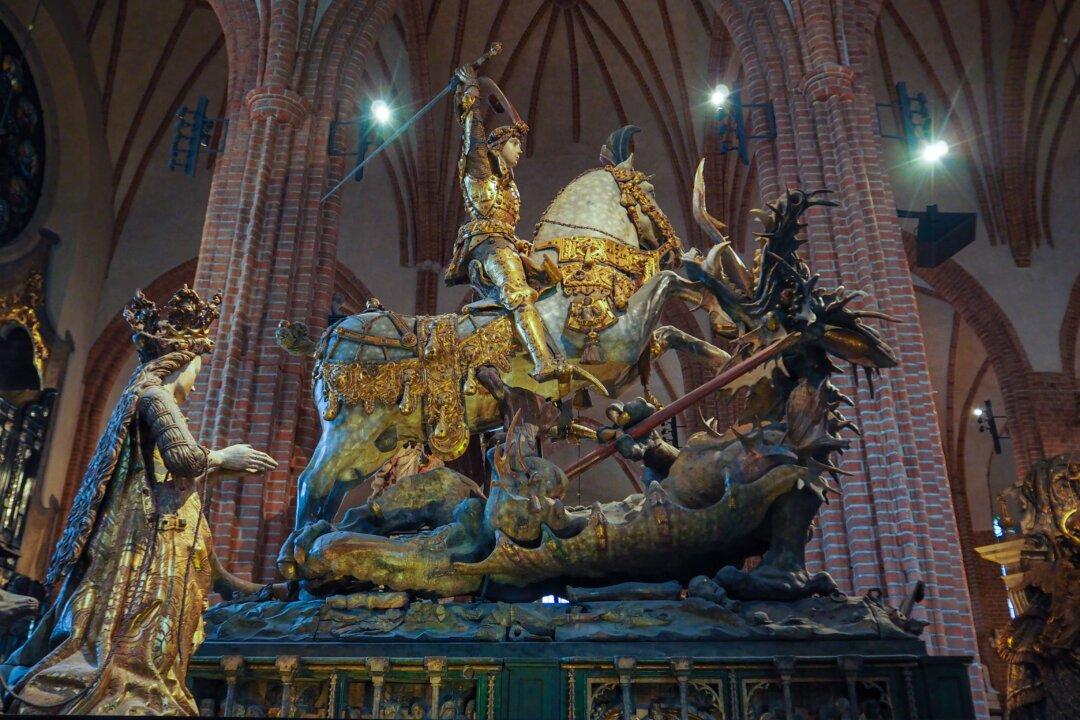Beautiful paintings in “The Art of Zhen Shan Ren International Art Exhibition” warn Texas residents of the real danger of unwittingly becoming involved in murder.
Paintings conveying pure beauty and evil hang side by side in the exhibition at the Gallery @ Courtyard in Plano, Texas. The 22 paintings, by internationally acclaimed artists, show both the profound beauty of the Chinese spiritual discipline of Falun Gong and the pure evil of the torture and forced organ harvesting carried out by the Chinese Communist Party (CCP) on Falun Gong practitioners just for practicing their faith.
All the artists featured in the exhibition practice Falun Gong, a faith that believes that “Zhen, Shan, Ren” (Truthfulness, Compassion, Tolerance) are the fundamental characteristics of the universe. Along with study and five meditative exercises, Falun Gong practitioners strive to align themselves with those three fundamental characteristics.
Many of the paintings on display allow viewers to peek into the artists’ personal spiritual practice, their experiences while practicing, and their visions of heaven. Some of the paintings explore the universal themes of good is rewarded and evil punished, and of devout resilience in the face of adversity. And each painting is imbued with the artist’s selfless intention to be a better person.

Many of the paintings in "The Art of Zhen Shan Ren International Art Exhibition" show the beauty of living a spiritual life. Southern USA Falun Dafa Association
“Art can hasten either the elevation or degeneration of people’s moral standards. [Good artwork] can broaden people’s mind ... making them nobler people,” Zhang Kunlun, one of the artists involved in the exhibition, told NTD, a sister media outlet of The Epoch Times. He went on to say: “If an artist wants to produce good artwork, the artist must first be a good person, a person with a higher moral standard than others. When one creates art, one must continuously purify oneself.”
Buddhas, Daos, and Gods, overflowing with divine grace and mercy, fill heavenly realms in some paintings. And the depths of hell are shown in others, although not for the sake of showing demons. Evil is only shown as part of a complete story. Hence, good is rewarded and evil is punished.

Heaven and Hell: Artworks show the sheer beauty of the spiritual practice of Falun Gong, alongside the horrific persecution of practitioners by the Chinese Communist Party. Southern USA Falun Dafa Association
Some of the paintings show the persecution of Falun Gong adherents in China. Since July 20, 1999, on the orders of former CCP leader Jiang Zemin, the communist regime has systematically tortured practitioners to force them into renouncing their faith. Rape, torture, and forced labor are some of the methods the communist regime uses to this day. Yet the practitioners in some of the paintings undergoing such persecution exude a peaceful inner strength and a tenacious spirit—strangely, even a kind of serenity as they uphold their faith.

Visitors to the exhibition in Plano, Texas, can observe the serenity of Falun Gong practitioners faced with religious persecution. Southern USA Falun Dafa Association

The painting “A Tragedy in China,” shows a grieving wife in front of her dead husband. She crosses her arms in a show of strength and resilience. Her tortured husband held on to his faith until the end. In his hand, he holds brainwashing papers that the Chinese regime uses to get Falun Gong practitioners to renounce their faith. The Art of Zhen Shan Ren
And then there are paintings that present what has been called “a new form of evil on this planet” by one prominent human rights lawyer: forced organ harvesting.
“The art is really profound. It’s a profound expression of the horrors of communist China’s forced organ harvesting. ... It’s a very, very powerful exhibit,” Texas State Rep. Matt Shaheen said to NTD at the opening of the Plano exhibition. Shaheen serves the citizens of District 66 in the Texas House of Representatives, representing West Plano and Far North Dallas.
On viewing the paintings, retired professor of economics Lydia Ortega said to NTD: “Bring tissues, OK. Because this exhibition will get to your heart. And that’s how paintings and artwork goes—it goes to the heart of you, when you see what people are expressing and recognize the truth of it.”
A Sickening Trade
Each year, thousands of desperately sick people from around the world travel to China in the hope of getting an organ transplant. In most countries, an organ donation match takes a considerable amount of time to arrange, but in China a match can be found in as little as two weeks. This is because the CCP forcibly takes these organs from prisoners of conscience. Falun Gong practitioners are believed to be the main victims of this state-sanctioned organ harvesting.
In the oil painting “Organ Crimes,” artist Xiqiang Dong depicts the forcible seizure of organs from a Falun Gong practitioner in China, while he is still alive. The Art of Zhen Shan Ren
Texans may be more aware of communist China’s human rights tragedy since June 7, when Texas officially and unanimously adopted a resolution condemning the Chinese regime’s systematic killing of prisoners of conscience for their organs. The resolution warns Texas citizens that if they travel to China for organ transplant surgery, they may be “unwittingly becoming involved in murder in the form of forced organ harvesting.”
Shaheen, the lead sponsor of the resolution, told NTD: “It’s really important that the state of Texas take a stand as far as condemning the practice by the Chinese government and the forced organ harvesting of practitioners of Falun Gong and really a lot of faiths and religions that are practiced in China.”
Falun Gong practitioner Adam Yao was at the Plano exhibition opening. He gave the final speech of the opening presentation, sharing how he was one of those who underwent terrifying torture while illegally detained in a Chinese prison. He feels fortunate to be one of the few who escaped (from the hospital he was sent to for injuries while in prison) to seek asylum in America. “But there remain numerous fellow practitioners who are still under persecution and face the threat of having their organs harvested,” he said.
“The Art of Zhen Shan Ren International Art Exhibition,” runs until July 2, at the Gallery @ Courtyard in Plano, Texas. From July 8 until July 22, the exhibition will be on display at James H. “Sloppy” Floyd Veterans Memorial Building in Atlanta.
Eva Fu and NTD contributed to this article.






